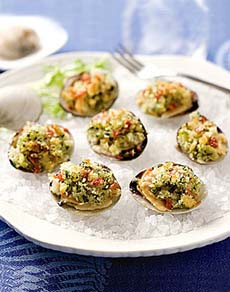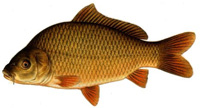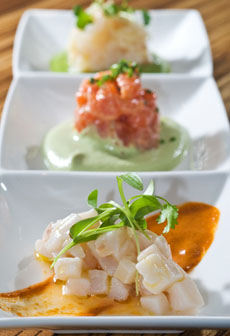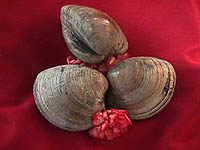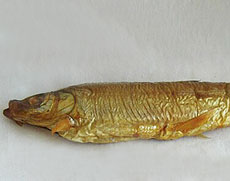|
||||||||||||||||||||||||||||||||||||||||||||||||||||||||||
|
A cephalopod is the most developed class of mollusk. Culinarily, it includes the cuttlefish, octopus and squid. Cephalopods have advanced beyond the need for an external shell, and all share two major characteristics: tentacles attached to the head (hence the name “head-foot” in Latin) and ink sacs. The sacs are used to evade predators; commercially, the ink is used to color pasta, among other food, black. Other than fried or grilled calamari (squid) and the occasional stuffed squid or seafood salad at an Italian restaurant, squid has never been widely accepted in the U.S., outside of Asian cuisines. In many southern European cuisines, it is quite popular. |
CEVICHE
|
Ceviche, pronounced suh-VEE-chay, is shellfish cured by citrus juice acid. The dish has been popular in Latin America for many centuries. It dates some 2,000 years to an Inca dish of raw marinated fish. The dish was discovered by Spanish conquistadors in the 1500s; they added the lime juice and onion that are integral to modern ceviche. The name is thought to come from the Spanish “escabeche,” meaning marinade. Alternate spellings include seviche and sebiche. In some countries, ceviche is so popular that there are cevicherias, restaurants that specialize in ceviche. June 28 is National Ceviche Day in Peru, where it one of the national dishes.
|
Photo courtesy PacSeafood.com. |
||
CHERRYSTONE CLAM or TOPNECK
|
This is a hard-shell, East Coast clam of medium-size—around 2 to 3 inches across. There are about three cherrystone clams to a pound. Cherrystones are frequently eaten on the half shell, though the sweeter littlenecks tend to be preferred raw. Cherrystones are also served cooked, with steaming and baking, e.g. Clams Casino, being the most popular cooking methods. They are also frequently referred to as topnecks. They are named after Cherrystone Creek, Virginia. See also clam. |
Photo courtesy of PhilsFishMarket.com. |
CHUB
|
A chub is a species of freshwater fish in the carp family, Cyprinidae. Chubs are common in Europe and North America. Not all specimens are tasty; some are game fish (and the smaller ones are used as bait). The chubs from the Great Lakes look like small whitefish but are a different species. Both chubs and whitefish are salt brined, cooked, and smoked whole. A smoked chub is golden in color. |
Photo courtesy of PhilsFishMarket.com. |
CLAM
|
There are two main varieties of these bivalve mollusks: hard-shell and soft-shell. Clams are variously named based on their size, region and sometimes personal decision of a merchant. Thus, think of the olive analogy (Medium, Large, Jumbo, Colossal, etc.): It’s best to order or buy by size, not by name.
|
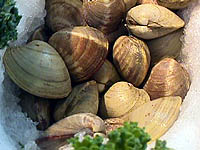 Littleneck clam is a hard-shell clam. The cherrystone is a larger variety of hard-shell clam. Photo courtesy of PhilsFishMarket.com. |
|
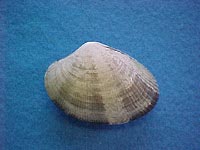 Manila clam. Photo courtesy Edmonds Discovery Programs. |
||
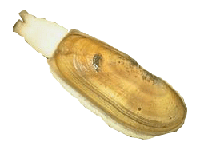 Razor clam is a West Coast longneck, or soft-shell, clam. Soft-shell clams have protruding necks. Other soft-shell clams are the East Coast steamer (also called Ipswitch) and Washington State geoduck. Photo courtesy of PacSeafood.com. |
||
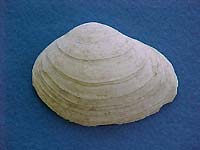 Soft-shell clam. Photo courtesy Edmonds Discovery Programs. |
-
The most common West Coast hard-shells are the Pacific littleneck clam (also know as a hardshell or rock clam), growing up to 2.5 inches across; the pismo, a large clam from California with a minimum legal size of 4 1/2 inches across; and the small, sweet butter clam from the Pacific Northwest. The Manila clam, which is produced in Washington state and British Columbia, was introduced from Asia in the 1930s. The largest clam resource on the West Coast, the Manila produces an annual harvest of about 10 million pounds. In Washington, the Manila is primarily farmed, while most of B.C.’s production comes from natural beds.
-
The Venus clam is a species new to the U.S. market. Farmed in remote bays along the West Coast of Mexico’s Baja Peninsula, it is placed in racks prior to harvesting to remove any grit. An excellent eating clam, the Venus clam is slightly larger and more economical than the Manila or Little Neck. The Venus clam is graded small (15 to 20 per pound), medium (10 to 20) and large (9 to 12).
-
The soft-shell clam, also called soft clam, doesn’t actually have a soft shell, but a rather thin and brittle one. It also can’t completely close its shell because of a long, rubbery foot (or “neck”) that extends out of the shell. The most common East Coast soft-shell is the steamer clam, commonly called steamers. They are also known as Ipswitch clams. Of the West Cost soft-shells, the most famous is the razor clam (named for its resemblance to a folded straight razor) and the geoduck clam (pronounced gooey-duck)—an odd-looking clam with a shell about 6 inches long, but with a foot that can reach outwards up to one-and-a-half feet.
When buying hard-shell clams in the shell, they must be live, just as with oysters. Be sure the shells are tightly closed. If slightly open, a light tap should make it snap shut. Otherwise, it’s dead and should not be eaten. So, too, for soft-shell clams; but to test them, a touch on the foot should make it move. Fresh-shucked clams should be plump with the shell holding clear liquid.
Clams tend to be a bit fishier and stronger than oysters in flavor. Steaming and baking are the most common ways of cooking. All clams need to be cooked gently, else they toughen. Clam trivia: Eastern Native Americans used parts of the shell from hardshell clams to make wampum—beads used for barter, among other purposes. Hence our use of wampum as another term for money or cash.
COCKLEAny of various small, jumping bivalves with heart-shaped, radially ribbed shells. Most don’t exceed 2 inches across. The rock cockle is the best known and most widely used for food. It’s found from the Pacific Northwest to San Francisco, and from large beds off England’s coast. As they burrow into mud or sand, they are typically quite gritty and so must be washed thoroughly. They have always been more popular in Europe than the United States—think linguine with clam sauce, a dish where the meat is less important than the liquid the shells hold. |
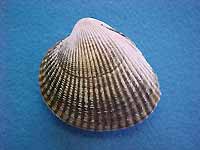 Heart cockle. Photo courtesy Edmonds Discovery Programs. |
||
Cockles are very similar to clams. Like clams, cockles can be eaten either raw or cooked. Many of the cockles sold in the U.S. are flown in live from New Zealand. Cockles from New Zealand’s South Island are larger (15 per pound) than cockles from the North Island (20-25 per pound).
CODCod is the name of an enormously popular and important fish, as well as a family of 60 species of fish that range from 1-1/2 to 100 pounds and come from the North Pacific and Atlantic Oceans. Cod, cusk, haddock, hake, pollock and whiting are all members of the cod family. The meat of all is mild-flavored, white, lean and firm. |
 Photo courtesy of TridentSeafoods.com. |
||
Even though it has been overfished and many restrictions have been placed on catching it, cod is still available year-round. Cod is prepared in many ways, including baking, poaching, braising, broiling, frying, stuffing, smoking, salting and drying. Salt Cod (bacalao in Spanish) is an important staple because it can be stored for long periods. Before it is used, it is soaked to rehydrate it and to remove some of the saltiness. Some consider cod cheeks and tongues a delicacy. Young cod is known as scrod. See also black cod.
CONCHPronounced conk, this gastropod is encased in the beautiful, brightly colored spiral shell frequently depicted in films as being a Pacific Islander’s clarion. Most types are carnivorous, feeding on bivalves. Conch is found in warm waters and is popular in Florida and the Caribbean, as well as in Southern Europe and China. Summer is the best season for fresh conch; it can also be found canned or frozen . It can be found in Chinese, Italian or specialty fish markets. It is often used in chowders, chopped, or can be eaten raw in salads, or quickly sautéed like abalone after being tenderized. Whelk is a related but different species that is often confused for conch. |
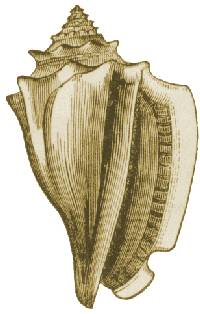 Image courtesy of Wikipedia. |
CORAL
The roe (eggs) of a crustacean. It gets its name from the coral-red color it turns when cooked. Roe is often eaten plain, even directly from a lobster or crab, or used in sauce or other preparation such as a butter. A female lobster or crab is often ordered for just this reason.
CRAB
|
Any one of a large variety of crustaceans that have a shell and 5 pairs of legs, the first pair of which have pincers. The are found in both cold and warm water, as well as fresh and salt water, though salt water crabs are more available. Crabs are noted for their sweet flesh. They are enormously popular in many cuisines around the world, and only shrimp are a more popular shellfish in the U.S.
|
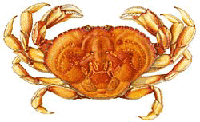 Dungeness crab. |
|
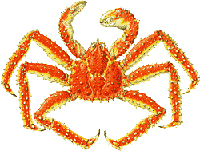 King crab. |
||
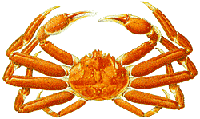 Snow crab. Crab illustrations courtesy of TridentSeafoods.com. |
Whole hard-shell crabs are available year-round in coastal areas. They can also be found canned as either lump or jumbo lump (which is whole pieces of white body meat) or flaked, also called backfin, which is small bits of meat, both light and dark, from the body and claws. Like most shellfish, crabs don’t keep well. Crab roe or coral is available only in the spring from female crabs and has been the traditional component of she-crab soup. Read more about types of crab and crabmeat grades in our extensive article and Crab Glossary.
CRAYFISH
|
Any of the more than 500 species of crustaceans that resemble tiny, pale to dark brown lobsters, including claws. They grow from 3 to 6 inches in length and weigh from 2 to 8 ounces. Most are fresh water species, a few are salt water. More than half of these species occur in North America, particularly in Kentucky around Mammoth Cave, and Louisiana in the Mississippi Basin. The rest of the species live mainly in Europe, New Zealand and East Asia. |
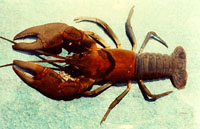 Photo courtesy of Dennison University. |
Crayfish are very popular in parts of the United States—where they are know regionally as crawfish, crawdaddy and crawdad. They are also very popular in France (called écrevisses), New Zealand and Scandinavia. Most of the U.S. crayfish come from the Mississippi Basin in Louisiana. They are prepared in many of the ways lobster can be cooked, size being the primary difference. Like lobsters, crayfish turn bright red when cooked. The tail meat is the only edible portion: The crayfish are snapped in half with the fingers and the meat is either sucked or picked out. Battered and fried, they are popularly know as Cajun popcorn.
CROAKERSee drum. CRUDOPronounced CREW-doe, this dish consists of raw fish or shellfish dressed with olive oil, sea salt, acidic juices such as lemon or lime and sometimes vinegar. It is similar to ceviche, except that ceviche is marinated only in citrus juice, without the olive oil. |
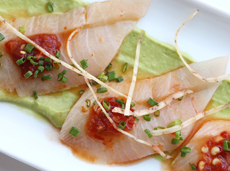 Crudo. Photo courtesy Zengo | New York. |
CRUSTACEAN
Crustaceans are shellfish that have a jointed (segmented) body with pairs of legs on each segment, and a tough exoskeleton. Crustaceans include the crab, crayfish, lobster and shrimp.
CUSKFound mainly in New England, this member of the cod family is a rather small saltwater fish, ranging from 1-1/2 to 5 pounds. It can be found whole or filleted. It has firm, almost chewy, lean, white flesh. Cusk can be prepared in any way cod can be. |
Photo copyright Thomas Wenneck, 2000-2005. |
CUTTLEFISH
|
The common name applied to predatory cephalopods with ten tentacles, eight of which, like squid, have suction cups on their inner surface plus two longer arms that can launch out to capture prey. They resemble a large squid and can reach up to 16 inches in length. Cuttlefish are quite tender, more than squid or octopus, but still need to be tenderized. They can be prepared like squid and octopus, and similar care must be taken not to overcook to prevent them from becoming overly chewy. Cuttlefish are popular in Japanese, Indian and Mediterranean cuisines, and can be found fresh, dried, or seasoned and roasted (called sarume in some Asian or specialty seafood markets—not to be confused with surimi, imitation crabmeat or “sea leg”). |
 Photo courtesy of YourDictionary.com . |
Continue To Page 4: Seafood Terms Beginning With D & E
Go To The Alphabet Index Above
Lifestyle Direct, Inc. All rights reserved. Images are the copyright of their respective owners.
![]()
© Copyright 2005-2025 Lifestyle Direct, Inc. All rights reserved. All images are copyrighted to their respective owners.




